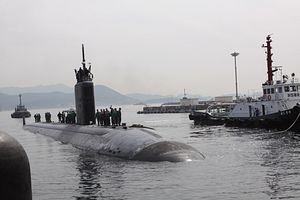U.S. President Donald Trump and his South Korean counterpart, Moon Jae-in, have reportedly discussed the development or procurement of nuclear-powered attack submarines (SSN) for the Republic of Korea (ROK) Navy during a bilateral summit held in Seoul today, according to a ROK government official.
While the ROK government official did not provide additional details of the discussion, the fact that president Moon mentioned South Korea’s interest in developing or purchasing nuclear submarines during today’s summit is indicative of the ROK government’s growing desire to acquire a SSN capability in the not too distant future.
The primary reason for the Moon administration’s push to acquire nuclear-powered SSNs reportedly is North Korea’s burgeoning submarine force including new conventionally-powered ballistic missile subs capable of firing the KN11/Pukguksong-1 submarine-launched ballistic missile (SLBM). Nuclear-powered subs, unlike diesel-electric submarines, can stay underwater for prolonged periods of time, which purportedly would allow them to track North Korean boomers more effectively.
Yet, how realistic is it that the ROK Navy will operate a small fleet of SSNs?
For starters, it is highly unrealistic to assume that the United States will sell or lease nuclear submarines such a Virginia-class or soon to be retired Los Angeles-class SSNs to South Korea for a number of reasons including nuclear proliferation fears, an unwillingness to share sensitive submarine technology with an ally, and the fact that the U.S.-made subs may just be too expensive to operate for the ROK Navy.
“The U.S. has never sold its nuclear-powered submarine to a foreign country,” a ROK government official said in September. Consequently, “if we choose to acquire (such subs), it would be in the form of indigenous development.” The ROK Navy would be interested in fielding at least three SSNs to guarantee round-the-clock patrols. Total cost for the acquisition of three subs plus supporting infrastructure could well approach $9 billion excluding operating cost, according to some estimates.
According to local media reports, South Korea launched a clandestine military project in 2003 code-named ‘362 initiative’ with the aim of developing an indigenous nuclear sub capability. Yet the program was shut down in 2004 when it became public and was brought to the attention of the International Atomic Energy Agency (IAEA). Before that, however, South Korea’s own atomic energy agency purportedly finished basic design work for a miniaturized nuclear reactor for a new class of SSNs.
Various obstacles both political and technical would need to be overcome to fulfill the Moon administration’s dream of a nuclear-powered submarine fleet. A major challenge for any future ROK Navy SSN fleet would be how to secure nuclear fuel. Under a revised U.S.-ROK nuclear deal signed in 2015, Seoul is prohibited from enriching uranium and reprocessing spent-fuel for military purposes, although it does allow enriching uranium for civil nuclear energy in the future. While a SSN could still run on low-enriched uranium, the United States would likely oppose such a move due to nuclear proliferation concerns.
“The two countries have yet to review whether or not the revision would allow South Korea to secure uranium necessary for a nuclear submarine,” a ROK defense ministry official told The Korea Times on the condition of anonymity in 2016. South Korea has also ratified the Nuclear Non-Proliferation Treaty (NPT) in 1975 and remains formally committed to it.
It would take at least five years for South Korea to build its first nuclear sub even with outside help, according to naval experts. An indigenous SSN program without foreign assistance is unrealistic. Potential international partners could include India, France, and the United States. The Trump administration has so far not publicly endorsed South Korea’s plans to push ahead with the project despite some media reports to the contrary.
The military utility of a SSN fleet also remains debatable.
The ROK Navy, a force primarily involved in littoral operations, is expected to field 18 diesel-electric attack subs by 2019–all which will be fitted with advanced sonar technology and air-independent propulsion systems. These subs will be able to stay submerged for two weeks or longer. Consequently, additional conventionally-powered subs could also guarantee persistence patrols around North Korean submarine bases.
Furthermore, diesel-electric submarines are generally quieter and harder to detect than nuclear boats. They would also be substantially less expensive than SSNs and could therefore be fielded in larger numbers. The ROK Navy could also field other assets besides submarines including anti-submarine warfare aircraft to detect and track North Korean subs.

































